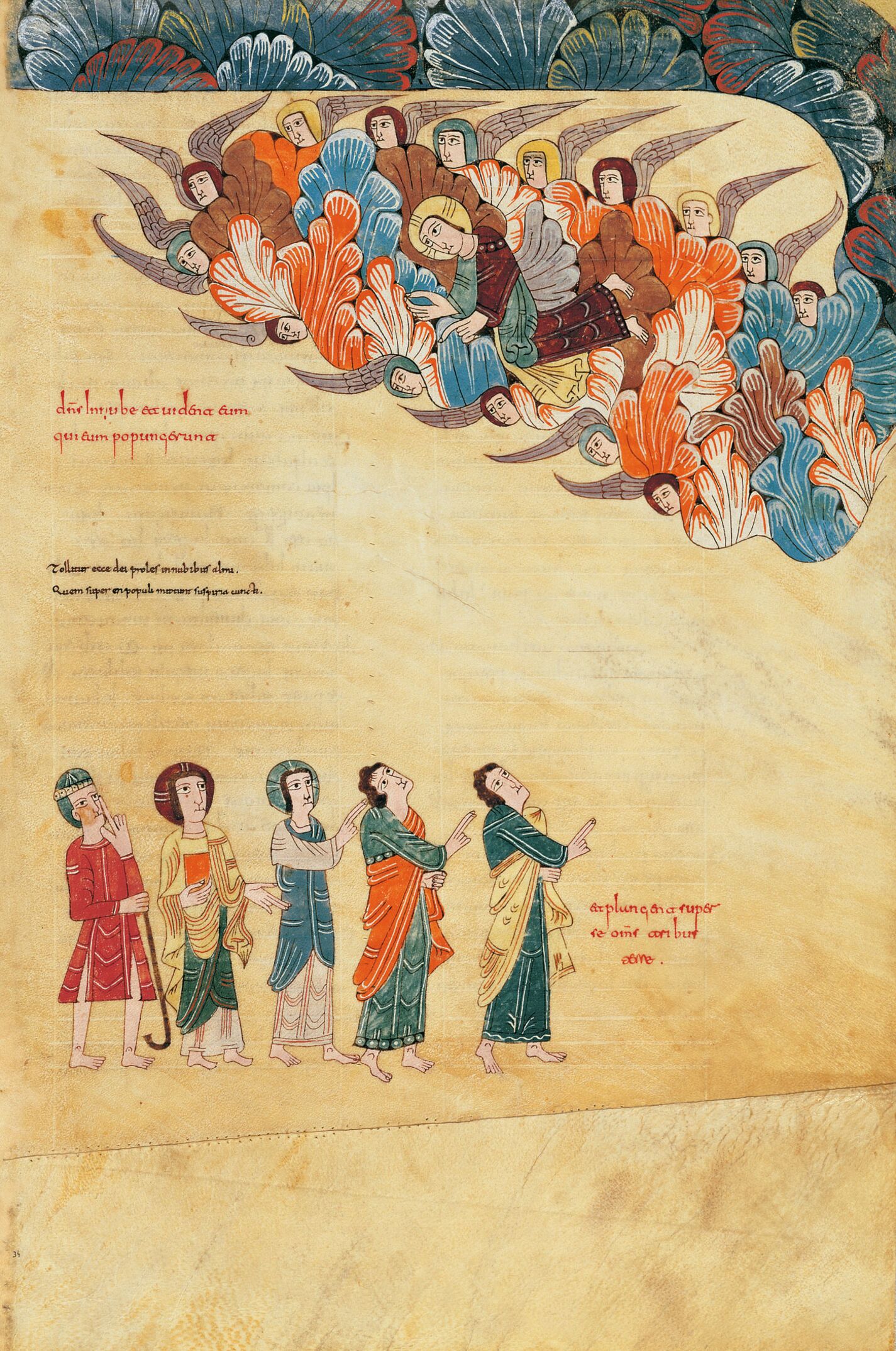This illustration deals with just the first verse of the Revelation. It covers the entire page and has no frame or coloured ground. Hence it is different from the tenth-century Beatus in stemma II and similar, albeit only in this respect, to some stemma I manuscripts based in all likelihood on the original model, whose North-African prototype could date from the 5th century. The composition is also unlike that of the other Beatus manuscripts which show the Lord above standing in stemma II, but enthroned in stemma I and situated in the centre of the folio flanked by angels. In stemma II the clouds surround him but are at his feet in stemma I. Beneath him are people looking up and pointing at him, shown as a compact group in stemma I and divided symmetrically in stemma II. In the Gerona Beatus, these very colourful and decorative clouds begin at the top of the folio and extend downwards from right to left, coving the bodies of the angels leaving just their heads and wings visible. Christ is shown in the middle genuflecting – a position used more for figures in flight such as some of the angels shown full-length winging their way across the heavens in this manuscript. He addresses the crowds, as shown by the gesture of his left hand, who are represented by five beardless figures, who represent in turn the five tribes of the earth. Four of them look upwards and point at him in accordance with the first part of verse 7, whilst the fifth, characterised by his cap and staff, raises his hand to his cheek in an ambiguous gesture of suffering that signifies the grief of the races of the earth described in the second part of verse 7. There are three legends: the first part of verse 7 on the left at the top: “d[omi]n[u]s in nube et uident eum/qui eum popungerunt”; one in the middle, written in the twelfth-century hand: “Tollitur ecce dei proles in nubibus almi/Quem super en populi mittunt supiriacuncti”; and finally, on the right at the bottom, the last part of the seventh verse: “et plangent super/se om[ni]s tribus terre”. In stemma II, the composition of this first apocalyptic theophany, inspired by the words of Christ reported in Matthew (24: 30 and 25: 31) and recorded in the Book of Daniel (Dan. 7: 13), does not represent the storia strictly being rather a figuration of an Ascension due to the anagogical meaning evoked in the commentary, which deems this event to be the second coming of Christ. The ways in which this image differs from those in the two pictorial stemmata of the Beatus manuscripts may suggest that it stemmed from another source.
Carlos Miranda García-Tejedor
Doctor in History
(Fragment of the Girona Beatus commentary volume)

This illustration deals with just the first verse of the Revelation. It covers the entire page and has no frame or coloured ground. Hence it is different from the tenth-century Beatus in stemma II and similar, albeit only in this respect, to some stemma I manuscripts based in all likelihood on the original model, whose North-African prototype could date from the 5th century. The composition is also unlike that of the other Beatus manuscripts which show the Lord above standing in stemma II, but enthroned in stemma I and situated in the centre of the folio flanked by angels. In stemma II the clouds surround him but are at his feet in stemma I. Beneath him are people looking up and pointing at him, shown as a compact group in stemma I and divided symmetrically in stemma II. In the Gerona Beatus, these very colourful and decorative clouds begin at the top of the folio and extend downwards from right to left, coving the bodies of the angels leaving just their heads and wings visible. Christ is shown in the middle genuflecting – a position used more for figures in flight such as some of the angels shown full-length winging their way across the heavens in this manuscript. He addresses the crowds, as shown by the gesture of his left hand, who are represented by five beardless figures, who represent in turn the five tribes of the earth. Four of them look upwards and point at him in accordance with the first part of verse 7, whilst the fifth, characterised by his cap and staff, raises his hand to his cheek in an ambiguous gesture of suffering that signifies the grief of the races of the earth described in the second part of verse 7. There are three legends: the first part of verse 7 on the left at the top: “d[omi]n[u]s in nube et uident eum/qui eum popungerunt”; one in the middle, written in the twelfth-century hand: “Tollitur ecce dei proles in nubibus almi/Quem super en populi mittunt supiriacuncti”; and finally, on the right at the bottom, the last part of the seventh verse: “et plangent super/se om[ni]s tribus terre”. In stemma II, the composition of this first apocalyptic theophany, inspired by the words of Christ reported in Matthew (24: 30 and 25: 31) and recorded in the Book of Daniel (Dan. 7: 13), does not represent the storia strictly being rather a figuration of an Ascension due to the anagogical meaning evoked in the commentary, which deems this event to be the second coming of Christ. The ways in which this image differs from those in the two pictorial stemmata of the Beatus manuscripts may suggest that it stemmed from another source.
Carlos Miranda García-Tejedor
Doctor in History
(Fragment of the Girona Beatus commentary volume)